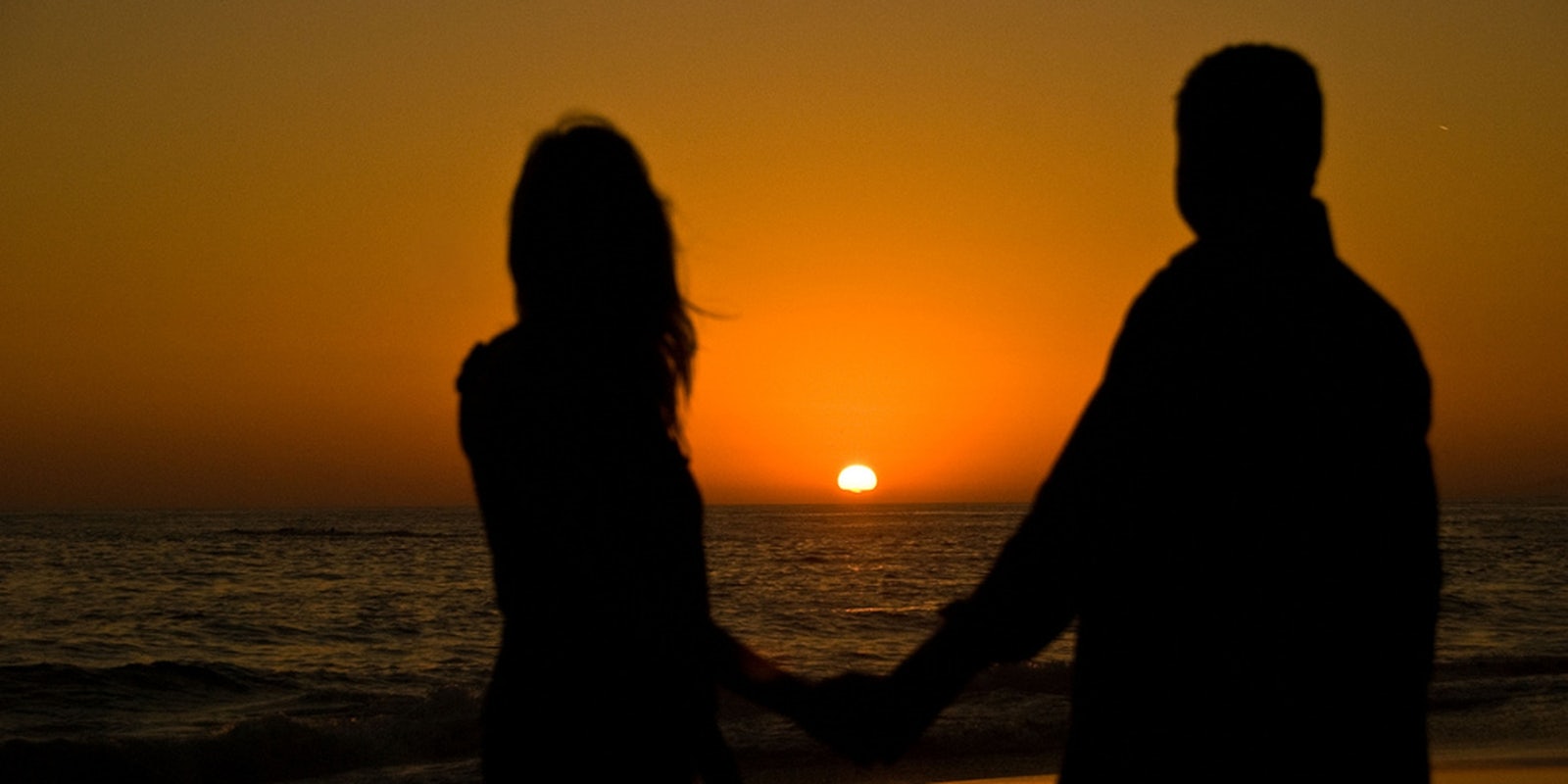Elan Miller is showing me his profile on Glimpse, the Instagram-based dating app he launched last week. The app has matched him up with a girl in her early 20, and he pulls up her Instagram default. She has tanned skin, long blonde hair, and a wide, easy smile. In short, she looks like pretty much any attractive girl you’d find on Instagram.
“We kinda took inspiration from the publishing industry,” he explains. “You’re walking through Barnes & Noble and you stop at a book cover and you’re like ‘Oh, that looks interesting.’ OK, cool, now that I’m in here, I’m able to go through the table of contents and zoom into a specific chapter.’”
He swipes her photo upward, Tinder-style, to pull up the rest of her profile. Most of her nine photos are her with her equally blonde and smiling friends; some of them are selfies of the duckfaced, bathroom mirror variety. In one of the photos, she and her friends are wearing Groucho Marx-style moustaches.
“So you can tell this girl’s cute, and she has a good sense of humor,” he says, “but you can also tell other things, like this girl is probably kinda self-indulgent cause it’s all photos of her rather than what she’s into. I think that’s what’s so great about Instagram: It provides a view into people’s lives that no other digital platform has been able to represent.”
I’m not sure I agree with Miller’s psychological assessment of the blonde girl in question: Is she actually self-indulgent because she has so many photos of herself on her profile, or is she trying to preempt the type of criticism users get on Tinder when they post photos of anything other than themselves? Nor am I particularly fond of his Barnes & Noble/dating analogy (though I’m sure the publishing industry, given its state, would appreciate the boost).
But I see his general point: Instagram and other image-based apps provide a window into daters’ lives that straight-up matchmaking sites like OkCupid and hookup apps like Tinder don’t necessarily offer.
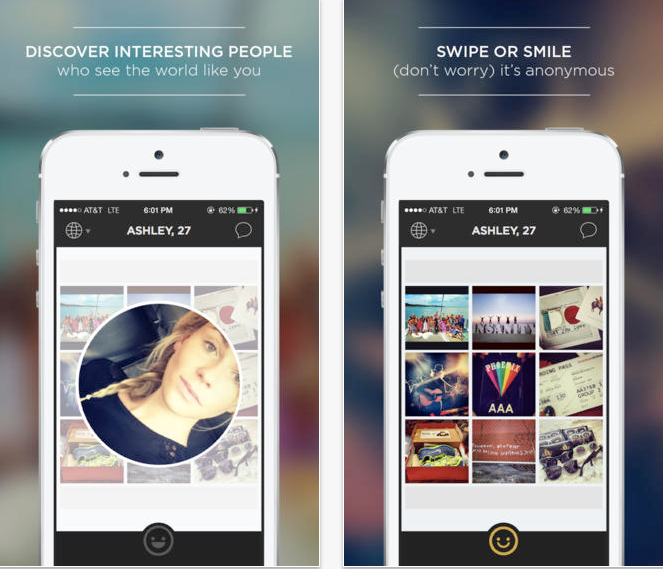
Screengrab via Glimpse/iTunes Store
Although people have been using Instagram as a de facto dating app for a while now (see the tale of Elizabeth Wisdom and Denis LaFargue, avid ‘grammers who met on the platform before getting engaged last winter), Glimpse is one of only a few dating apps that is specifically built for the platform. (Similar apps like Kisstagram and Instadating are offered online, but appear to not be offered through the app store.)
With Glimpse, users enter their basic information into the app (gender, birth date, sexual orientation) and then upload their top nine Instagram photos to their profile, which can be everything from sepia-filtered selfies to photos from that sushi joint you went to on your last vacation to Miami Beach.
Miller and his team founded Glimpse about a year ago, as a response to his own mixed experiences with online dating. “I’d used OKCupid, Tinder, other emerging apps, but I just never got that into it,” he said when I met him for coffee earlier this week. “It wasn’t that I wasn’t getting dates, but they were very boring. Then I took a look at my profile, and I was like, ‘I don’t really come off like me. Like, it’s me on paper, but it doesn’t really feel like me.”
Miller and his friends are avid Instagram users, and when he took a look at his account, “immediately I thought it gave a much better sense of who I was,” he says. He developed the app with his team for over a year, launching it last week in time for Valentine’s Day. After announcing its launch on Medium, it received a great deal of press attention, to the point where Miller says he is fielding “thousands” of requests to sign up for the app (it is currently invitation-only).
Basically, here’s how Glimpse works: After you upload your profile to the app, you’re invited to browse the profiles of its members (they’re currently selected randomly from all over the world, but Miller hints he’ll be adding a geolocation feature in the near future). If you “smile” at a user, that person receives a notification and is given the option to “smile” at you. If it’s a match, you can message the person through the app.
In this respect and a few others, such as its swipe-through feature, Glimpse clearly takes its inspiration from Tinder. But Miller says Tinder and Glimpse differ in one key regard: While Tinder is a “great ego boost” that’s “great for hookups,” Glimpse wants to inspire its users to engage in deeper, more meaningful conversations. “The problem is when you go on a Tinder date, you don’t know what to say to that person, other than ‘We’re attracted to each other and we wanna hook up now,’” he says. “Tinder is more ‘Hot or Not.’ It’s Angry Birds with cute girls. We’re more ‘Interesting or Not.’”
By providing a window into people’s interests—”their sense of style, their favorite bands, whether or not they have any pets”—Instagram, Miller says, is more representative of an individual’s personality than any other social media platform on the market. Discovering shared interests via Instagram also provides a more naturalistic segue into a conversation, as opposed to a dating platform like OKCupid, where female users are often inundated with creepy requests from suitors.
“I started a conversation with a girl who posted a photo of that Massive Attack show on the Park Armory, and I was like, ‘Oh, I was there too,’” Miller says. “It was just so natural and effortless versus a cheesy pickup line or ‘Hey, what’s up.’ Women are more comfortable and from a guy’s perspective too, it’s like, I’m sick of trying so hard. Here you can just chat instead of having to go the whole nine yard before meeting each other.”
Of course, if you’re only a sporadic user of Instagram, as I am, Glimpse might not be the app for you, as you have fewer options for what you can choose to put on your profile. Because my Instagram primarily consists of photos of my cat, food, and doodles of Law and Order characters, my Glimpse profile makes me look like a gluttonous, TV-obsessed crazy cat lady (which is not an inaccurate representation, but still):
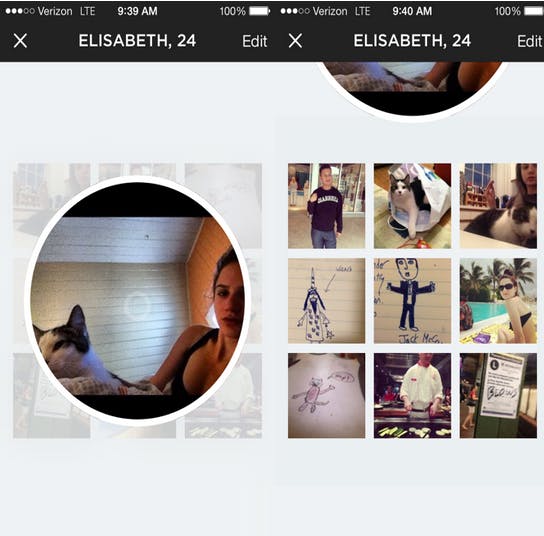
Screengrabs via Glimpse
Additionally, Glimpse poses the potential issue of misrepresentation, or users presenting glossier, more idealized versions of themselves. While this is a concern with virtually any dating app, it seems like it particularly applies to an Instagram-based app like Glimpse, which gives even the most non-Photoshop-savvy user the tools to tint, crop, and tone any flaws that might be glaring in a nonaltered photo.
When people have the opportunity to curate their own lives, as Instagram and other social media platforms allow them to do, they’ll often seize on it to present a hipper, sexier, more cosmopolitan version of themselves. An Instagram photo of a glorious sunset during a weekend jaunt to Jakarta, for instance, could just as easily be an expertly filtered snapshot of that same sunset in Great Neck, Long Island.
The potential for misrepresentation seemed particularly apparent to me when I started using Glimpse and instantly realized that absolutely everyone on the app was infinitely cooler, sexier, and more well-traveled than I was:
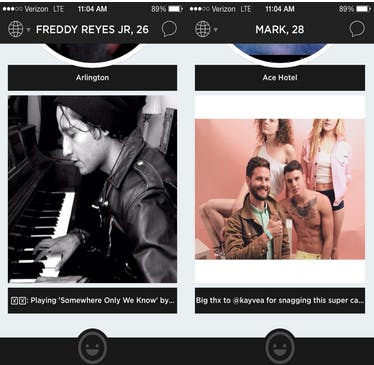
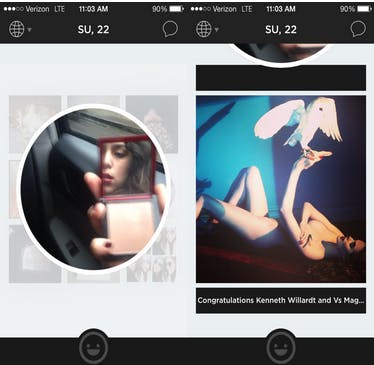
Screengrabs via Glimpse
When I brought this up to Miller—i.e., that everyone on Glimpse seemed a hell of a lot sexier than the average dating app user—he reacted with surprise. But he did acknowledge that the fact that Glimpse is currently invitation-only allows them to screen more rigorously for their first users, which gives the app a tinge of elitism. While he insists that doesn’t mean screening for superficial factors, such as race, age, physical appearance, and the like, he noted the importance of cultivating the appropriate “culture” for an app like Glimpse in its earliest stages.
“We want to have a diverse crowd from a bunch of places, and it’s tough because we want interesting people who tell a full story rather than just showcasing what they look like,” he says. “So basically if your Instagram profile is just a bunch of bathroom selfies, it’s probably not the right app for you. We want to set the culture of the app with the first few thousand users by having people who share not just what they look like, but how they see the world. What you look like is important, but your visual perspective is much more so.”
Although Miller declined to disclose numbers for Glimpse’s userbase, he says that there are currently “thousands” of people on a waiting list for the app, many of whom are from countries like Brazil and Mexico, where Instagram culture is thriving. He also notes that he’s had more women than men request to sign up for Glimpse—unusual for a dating app, which traditionally skews slightly male, but fairly consistent with Instagram’s userbase, 53 percent of which are women.
So the question is, how much does Glimpse actually provide a glimpse (see what I did there?) into their users’ lives? Are dating app users truly interested in getting a sepia-tinted view of the world through a prospective partner’s eyes? Miller is betting that they are.
“The social Web is moving toward showing, not telling,” he says. “Ten years ago, it was all about where you went to school, but now nobody cares where you went to school. It’s all about, did you post an interesting photo at Burning Man or Coachella? That’s how you gain social credibility and social capital.”
Photo by Gregory Jordan/Flickr (CC BY – NC – ND 2.0)

